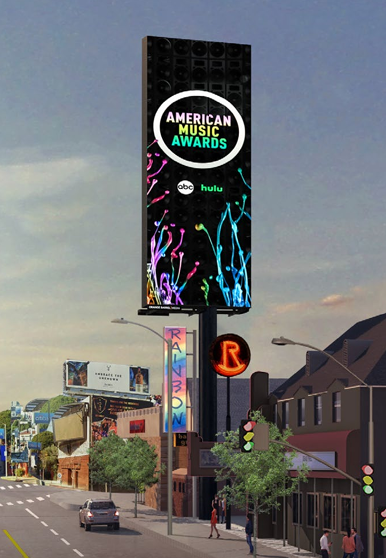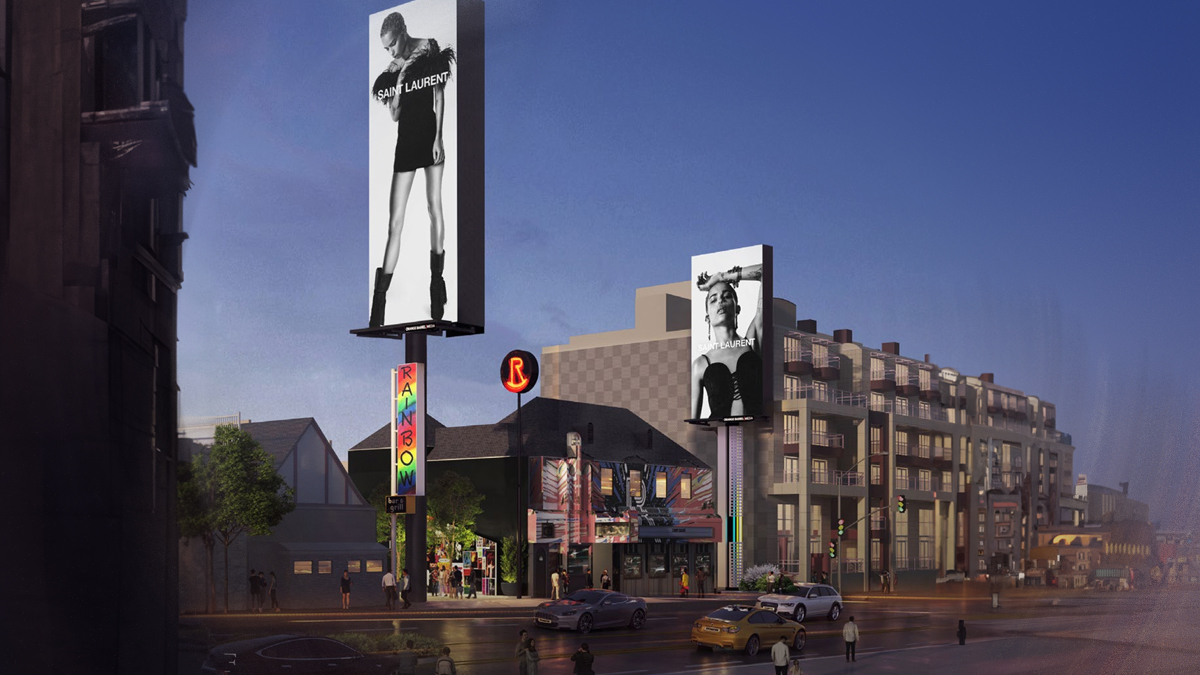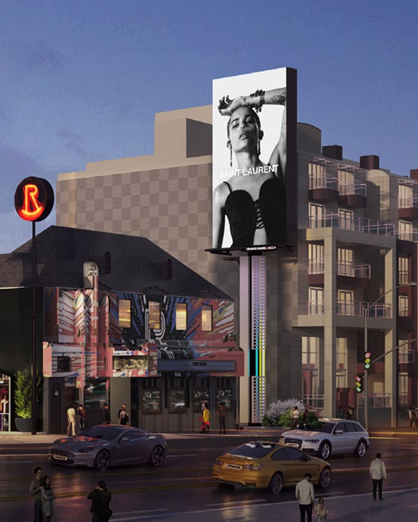West Hollywood’s Planning Commission will decide tonight whether they will get behind two major proposed changes to the visual landscape of the Sunset Strip.
They will hold a public hearing concerning a request to permit the installation of a new internally lit billboard at 9009 Sunset Boulevard, the location of Roxy Theatre, and the conversion of an existing static billboard to a new digital and internally lit billboard at 9015 Sunset Boulevard, the location of Rainbow Bar & Grill.
The Commission will discuss the merits of the proposal and will subsequently provide recommendations to the City Council on various approvals required.
City staff recommends that the Planning Commission endorse the Sign Permit, Certificate of Appropriateness, and Development Agreement for both addresses along with a Zoning Map Amendment. The staff report also outlines five draft resolutions that encapsulate the different aspects of the project, including approval of Development Agreements, Zoning Map Amendment, Sign Permit, and Certificate of Appropriateness for both addresses.
HOW THINGS STARTED
The application for this project was originally submitted on November 3, 2020, by Andrew Bilanzich of ACE Outdoor Group on behalf of the property owner, BMA Sunset LLC. The application covers a Master Project, Certificate of Appropriateness, Sign Permit, Zoning Map Amendment, and Development Agreement Overlay. Both billboards were initially reviewed and recommended for approval by the Sunset Arts & Advertising Committee, the Historic Preservation Commission, and the Planning Commission. Later, the owner switched billboard operators to Orange Barrel Media, resulting in revised billboard designs. These revised designs have been reviewed and endorsed by the Sunset Arts & Advertising Committee and the Historic Preservation Commission. Both buildings, Roxy Theatre and Rainbow Bar & Grill, were designated as local cultural resources on November 4, 2019.
The properties are currently zoned under the SSP-Sunset Specific Plan and have received a Negative Declaration under the environmental review process. Public notices for the hearing were distributed in accordance with WHMC Section 19.74.020.
Roxy Theatre at 9009 Sunset Boulevard is a two-story, 34-foot-tall building that currently has five wall signs, a pole sign, and a front marquee sign.
Rainbow Bar & Grill at 9015 Sunset Boulevard is a one-and-a-half-story, 25-foot-tall building that has a two-sided billboard and a blade sign on a pole. Both buildings have been operating since the early 1970s and are designated as cultural resources.
The area behind these buildings is used for talent and equipment loading and unloading, and parking. The properties are adjacent to a single-family home to the north, an office tower to the south, another office building to the east, and a single-story bank building to the west.
HOW WE GOT HERE
The project’s previous designs were reviewed in 2021 by multiple bodies, including the Sunset Arts & Advertising Subcommittee, the Historic Preservation Commission (HPC), and the Planning Commission. Following these initial reviews, the media company for the project was switched to Orange Barrell Media (OBM), resulting in a redesign. This redesign aimed to address concerns that had been raised in the previous reviews as well as to better align with OBM’s requirements.
In the current design, significant changes have been made to both billboards. The Roxy Theatre’s billboard is now a simplified, vertical, one-sided internally lit billboard that doesn’t overhang the building. The billboard for the Rainbow Bar & Grill has been altered to remove its middle section and seating area at the bottom, a change that came in response to HPC’s feedback that the historic Rainbow can sign looked too crowded. The existing iconic signs for both venues, the rainbow-colored can sign for the Rainbow and the rounded “Rocking R” sign for the Roxy, will remain in place. The “Rocking R” sign will be lowered to improve its legibility.
The Sunset Arts & Advertising Subcommittee reviewed the current designs in its meeting on March 9, 2023. The subcommittee was generally supportive of the designs but made several suggestions. These included reconsidering the height proportions between the two billboards, bringing the Roxy billboard flush with the adjoining building, and reducing the extent to which the Rainbow billboard encroached over the right-of-way. The applicant has made adjustments in response to some of these suggestions, including lowering the height of the Rainbow billboard by four feet and adjusting the Roxy billboard’s position and rear material.
Similarly, the HPC reviewed the new designs on June 27, 2023, and unanimously recommended approval. The HPC was particularly satisfied that the new designs addressed previous concerns about sign crowding and visibility.
SIGN POLICY
The Sunset Boulevard Off-Site Signage Policy. This policy was adopted by the City on March 18, 2019, and subsequently amended on October 7, 2019. It serves as the City’s first comprehensive policy update specifically for billboards and other types of creative advertising along the Sunset Strip, a significant economic hub for West Hollywood. The Policy is intended to integrate advertising, public art, and entertainment into the existing built environment of the Sunset Strip, thereby enhancing its unique character. It emphasizes the need for design excellence, innovation, compatibility with the existing context, sustainability, economic development, and community benefit.
To implement this policy, a design excellence review and award process was established, running from November 2019 to June 2020. Projects had to demonstrate high levels of creativity and alignment with the design principles laid out in the Policy. After a competitive vetting process, the first 21 projects were selected to proceed, and the current billboard application is one of those. The design principles aim to build on the creative energy of the Sunset Strip and synthesize various elements including advertising, urban design, architecture, and public art.
 THE BILLBOARDS
THE BILLBOARDS
The design philosophy behind the new billboards is to complement the rock-and-roll history that is integral to both buildings. Both venues were designated as cultural resources, and the billboards aim to align with the cultural and historical significance of the Sunset Strip, particularly its role as a dining, entertainment, and nightclub destination in the 1970s and 1980s.
The backside of the Roxy’s billboard will feature powder-coated matte black metal panels with no advertising. The supporting pole at the base will be clad in perforated metal, featuring rainbow-colored light tubes that can be changed but are intended to match the historic Rainbow sign.
The Rainbow’s billboard faces will measure 1,000 square feet. The billboard will continue to encroach into the public right-of-way by 8’-9”, consistent with the existing sign.
The project also includes site improvements for both venues, particularly for the Rainbow Bar & Grill. These improvements include creating a permanent outdoor dining space, installing new permeable pavers, and adding planters and trees. New string lighting will also be installed. The project will remove the existing curb cut between the Rainbow and the Roxy to create a more cohesive outdoor area. This aligns with the broader vision of enhancing streetscape improvements to bolster the cultural and commercial viability of the venues.
HOW THEY MEASURE UP
The project is reviewed against the Sunset Boulevard Off-Site Signage Policy Standards, with focus on Sections 3, 4, 5, and 6. The proposed billboards substantially meet the relevant standards. For instance, the project is permitted as a digital conversion on a cultural resource for the Rainbow and a reallocation of existing sign area for the Roxy. A Development Agreement and Design Excellence award have been granted. Standards related to sightlines, public & arts programming, and ground disturbance are also met or addressed. In instances where the project exceeds certain standards, such as the height of the billboards, it is reviewed as an alternative project with community benefits outlined in the development agreement.
In terms of lighting and operational standards (Section 5), the document specifies that both proposed billboards will adhere to the required conditions for lighting and operation. This includes sign luminance, which is the light passing through the sign, and sign illuminance, the light hitting objects such as the street. The digital sign control and image transition, as well as visual comfort and contrast control for motorists, are all taken into account. Renewable energy sources, audio, and monitoring are also considered. These standards are set as a condition for project approval.
Architectural lighting (Section 6) could be used to enhance a building’s façade, but the proposed billboards for the Roxy and Rainbow will not employ this feature. However, the Roxy will have light tubes in the sign pole, and the trees in the Rainbow’s courtyard and the poster wall will have up-lighting, along with string lighting across the outdoor dining area.
WHAT WEHO GETS BACK
The Policy allows for what it calls “alternative projects,” designed to encourage creative proposals that may not strictly meet all the established standards but align with the overall vision of the Policy. Both proposed billboards fall into this category. The Roxy billboard exceeds the height limit by almost 22 feet, and the Rainbow billboard exceeds both the height and allowable sign area. However, they meet all other applicable standards. To provide “extraordinary benefits” to the City, the applicant is funding a program called the “Legends of Sunset,” which aims to celebrate the entertainment legacy of the Sunset Strip through various physical installations and improvements.
The Development Agreement is a crucial part of the project. It is a contractual arrangement that grants the project vested rights in exchange for public benefits. The Commission reviews the agreement and recommends approval or denial to the City Council. The agreement must meet various findings and components specified in the Zoning Code. Among the primary points of these agreements are Public Benefit Payments, which require the owner/operators of Roxy and Rainbow to pay a percentage of their projected gross revenues annually. These payments are subject to a 3% escalation each year.
Additionally, both venues receive a Historic Property Credit against their Public Benefit Payments, which differs in amount and is reduced after the first five years of the agreement. They are also required to provide an “Extraordinary Benefit,” specifically for planning and implementing the Legends of Sunset program.
The development agreement also outlines the obligations for Public & Arts Programming. The Roxy is required to provide 1% of the projected revenue each year for this purpose, while the Rainbow has more complex requirements, including 17.5% of City content time for digital arts programming on its digital face.
Digital Sign Programming for the Rainbow specifies that the owner/operator should use technology allowing coordinated programming across other digital billboards. Both billboards must update their digital and static technology to City standards at least every eight years. There are also requirements for building occupancy and usage: the Roxy must remain an entertainment venue and the Rainbow a restaurant/bar for the entire term of the agreement.
Green energy practices are mandated for both billboards, and the owners must apply for a Mills Act Contract before initiating advertising content. If the contract expires, a rehab plan must be submitted within six months.


